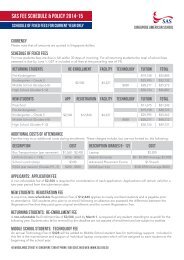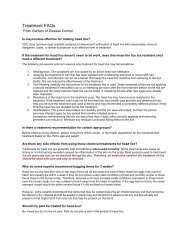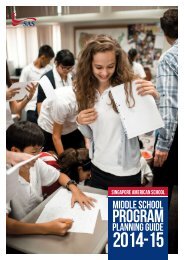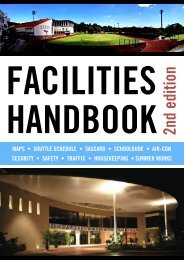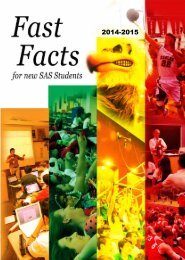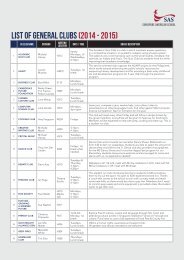Math 6+ - Singapore American School
Math 6+ - Singapore American School
Math 6+ - Singapore American School
You also want an ePaper? Increase the reach of your titles
YUMPU automatically turns print PDFs into web optimized ePapers that Google loves.
<strong>Singapore</strong> <strong>American</strong> <strong>School</strong> Middle <strong>School</strong> <strong>Math</strong> Curriculum: <strong>Math</strong> <strong>6+</strong> 2 G6.NS.6G6.NS.7G6.NS.8Understand a rational number as a point on the number line. Extend number line diagrams and coordinate axes familiar from previous grades to represent points on the line and in the plane with negative number coordinates. G6.NS.6a Recognize opposite signs of numbers as indicating locations on opposite sides of 0 on the number line; recognize that the opposite of the opposite of a number is the number itself, e.g., –(–3) = 3, and that 0 is its own opposite. G6.NS.6b Understand signs of numbers in ordered pairs as indicating locations in quadrants of the coordinate plane; recognize that when two ordered pairs differ only by signs, the locations of the points are related by reflections across one or both axes. G6.NS.6c Find and position integers and other rational numbers on a horizontal or vertical number line diagram; find and position pairs of integers and other rational numbers on a coordinate plane. Understand ordering and absolute value of rational numbers. G6.NS.7a Interpret statements of inequality as statements about the relative position of two numbers on a number line diagram. For example, interpret –3 > –7 as a statement that –3 is located to the right of –7 on a number line oriented from left to right. G6.NS.7b Write, interpret, and explain statements of order for rational numbers in real-world contexts. For example, write –3 o C > –7 o C to express the fact that –3 o C is warmer than –7 o C. G6.NS.7c Understand the absolute value of a rational number as its distance from 0 on the number line; interpret absolute value as magnitude for a positive or negative quantity in a real-‐world situation. For example, for an account balance of –30 dollars, write |–30| = 30 to describe the size of the debt in dollars. G6.NS.7d Distinguish comparisons of absolute value from statements about order. For example, recognize that an account balance less than –30 dollars represents a debt greater than 30 dollars. Solve real-‐world and mathematical problems by graphing points in all four quadrants of the coordinate plane. Include use of coordinates and absolute value to find distances between points with the same first coordinate or the same second coordinate. Strand 4: Expressions and Equations G6.EE Apply and extend previous understandings of arithmetic to algebraic expressions. G6.EE.1 Write and evaluate numerical expressions involving whole-‐number exponents. G6.EE.2Write, read, and evaluate expressions in which letters stand for numbers. G6.EE.2a Write expressions that record operations with numbers and with letters standing for numbers. For example, express the calculation “Subtract y from 5” as 5 – y. G6.EE.2b Identify parts of an expression using mathematical terms (sum, term, product, factor, quotient, coefficient); view one or more parts of an expression as a single entity. For example, describe the expression 2 (8 + 7) as a product of two factors; view (8 + 7) as both a single entity and a sum of two terms. G6.EE.2c Evaluate expressions at specific values of their variables. Include expressions that arise from formulas used in real-‐world problems. Perform arithmetic operations, including those involving whole-‐number exponents, in the conventional order when there are no parentheses to specify a particular order (Order of Operations). For example, use the formulas V = s 3 and A = 6 s 2 to find the volume and surface area of a cube with sides of length s = 1/2. Common Core State Standards for <strong>Math</strong>ematics Adopted by The Board on January 2013 January 2013
<strong>Singapore</strong> <strong>American</strong> <strong>School</strong> Middle <strong>School</strong> <strong>Math</strong> Curriculum: <strong>Math</strong> <strong>6+</strong> 3 G6.EE.3G6.EE.4Apply the properties of operations to generate equivalent expressions. For example, apply the distributive property to the expression 3 (2 + x) to produce the equivalent expression 6 + 3x; apply the distributive property to the expression 24x + 18y to produce the equivalent expression 6 (4x + 3y); apply properties of operations to y + y + y to produce the equivalent expression 3y. Identify when two expressions are equivalent (i.e., when the two expressions name the same number regardless of which value is substituted into them). For example, the expressions y + y + y and 3y are equivalent because they name the same number regardless of which number y stands for. Reason about and solve one-‐variable equations and inequalities. G6.EE.5 Understand solving an equation or inequality as a process of answering a question: which values from a specified set, if any, make the equation or inequality true? Use substitution to determine whether a given number in a specified set makes an equation or inequality true. G6.EE.6G6.EE.7G6.EE.8Use variables to represent numbers and write expressions when solving a real-‐world or mathematical problem; understand that a variable can represent an unknown number, or, depending on the purpose at hand, any number in a specified set. Solve real-‐world and mathematical problems by writing and solving equations of the form x + p = q and px = q for cases in which p, q and x are all nonnegative rational numbers. Write an inequality of the form x > c or x < c to represent a constraint or condition in a real-world or mathematical problem. Recognize that inequalities of the form x > c or x < c have infinitely many solutions; represent solutions of such inequalities on number line diagrams. Represent and analyze quantitative relationships between dependent and independent variables. G6.EE.C.9 Use variables to represent two quantities in a real-‐world problem that change in relationship to one another; write an equation to express one quantity, thought of as the dependent variable, in terms of the other quantity, thought of as the independent variable. Analyze the relationship between the dependent and independent variables using graphs and tables, and relate these to the equation. For example, in a problem involving motion at constant speed, list and graph ordered pairs of distances and times, and write the equation d = 65t to represent the relationship between distance and time. Strand 5: Geometry G6.G Solve real-‐world and mathematical problems involving area, surface area, and volume. G6.G.1 Find the area of right triangles, other triangles, special quadrilaterals, and polygons by composing into rectangles or decomposing into triangles and other shapes; apply these techniques in the context of solving real-‐world and mathematical problems. G6.G.2G6.G.3G6.G.4Find the volume of a right rectangular prism with fractional edge lengths by packing it with unit cubes of the appropriate unit fraction edge lengths, and show that the volume is the same as would be found by multiplying the edge lengths of the prism. Apply the formulas V = l w h and V = b h to find volumes of right rectangular prisms with fractional edge lengths in the context of solving real-‐world and mathematical problems. Draw polygons in the coordinate plane given coordinates for the vertices; use coordinates to find the length of a side joining points with the same first coordinate or the same second coordinate. Apply these techniques in the context of solving real-‐world and mathematical problems. Represent three-‐dimensional figures using nets made up of rectangles and triangles, and use the nets to find the surface area of these figures. Apply these techniques in the context of solving real-‐world and mathematical problems. Draw, construct, and describe geometrical figures and describe the relationships between them. G6.G.5 Solve problems involving scale drawings of geometric figures, including computing actual lengths and areas from a scale drawing and reproducing a scale drawing at a different scale. Common Core State Standards for <strong>Math</strong>ematics Adopted by The Board on January 2013 January 2013
<strong>Singapore</strong> <strong>American</strong> <strong>School</strong> Middle <strong>School</strong> <strong>Math</strong> Curriculum: <strong>Math</strong> <strong>6+</strong> 4 G6.G.6G6.G.7Draw (freehand, with ruler and protractor, and with technology) geometric shapes with given conditions. Focus on constructing triangles from three measures of angles or sides, noticing when the conditions determine a unique triangle, more than one triangle, or no triangle. Describe the two-‐dimensional figures that result from slicing three-‐dimensional figures, as in plane sections of right rectangular prisms and right rectangular pyramids. Solve real-‐life and mathematical problems involving angle measure, area, surface area, and volume. G6.G.8 Know the formulas for the area and circumference of a circle and use them to solve problems; give an informal derivation of the relationship between the circumference and area of a circle. G6.G.9G6.G.10Use facts about supplementary, complementary, vertical, and adjacent angles in a multi-‐step problem to write and solve simple equations for an unknown angle in a figure. Solve real-‐world and mathematical problems involving area, volume and surface area of two-‐ and three-‐dimensional objects composed of triangles, quadrilaterals, polygons, cubes, and right prisms. Strand 6: Statistics and Probability G6.SP Develop understanding of statistical variability. G6.SP.1 Recognize a statistical question as one that anticipates variability in the data related to the question and accounts for it in the answers. For example, “How old am I?” is not a statistical question, but “How old are the students in my school?” is a statistical question because one anticipates variability in students’ ages. G6.SP.2G6.SP.3Understand that a set of data collected to answer a statistical question has a distribution, which can be described by its center, spread, and overall shape. Recognize that a measure of center for a numerical data set summarizes all of its values with a single number, while a measure of variation describes how its values vary with a single number. Summarize and describe distributions. G6.SP.4 Display numerical data in plots on a number line, including dot plots, histograms, and box plots. G6.SP.5Summarize numerical data sets in relation to their context, such as by: G6.SP.5a Reporting the number of observations. G6.SP.5b Describing the nature of the attribute under investigation, including how it was measured and its units of measurement. G6.SP.5c Giving quantitative measures of center (median and/or mean) and variability (interquartile range and/or mean absolute deviation), as well as describing any overall pattern and any striking deviations from the overall pattern with reference to the context in which the data were gathered. G6.SP.5d Relating the choice of measures of center and variability to the shape of the data distribution and the context in which the data were gathered. Common Core State Standards for <strong>Math</strong>ematics Adopted by The Board on January 2013 January 2013



